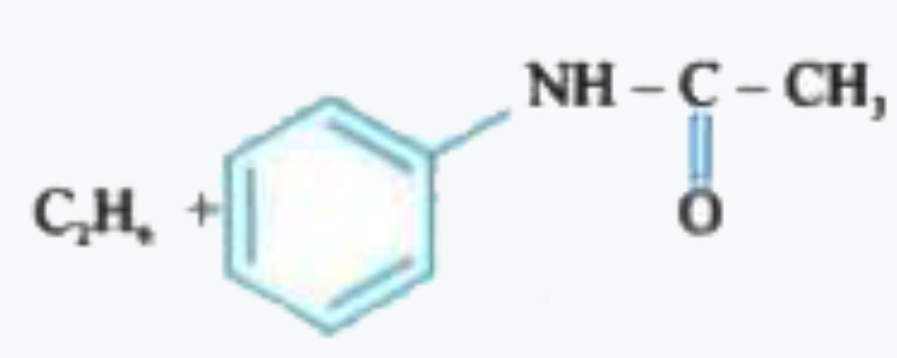Aniline reacts with acetaldehyde to form
Schiff's base
Carbylamine
Immine
None of these
The correct Answer is:A
To determine the product formed when aniline reacts with acetaldehyde, we can follow these steps:
Step 1: Identify the Reactants
- Aniline is a primary amine with the structure C6H5NH2.
- Acetaldehyde is a carbonyl compound with the structure CH3CHO.
Step 2: Understand the Reaction Mechanism
- When a primary amine (like aniline) reacts with an aldehyde (like acetaldehyde), they typically undergo a condensation reaction to form an imine (also known as a Schiff base).
- The reaction involves the nucleophilic attack of the amine on the carbonyl carbon of the aldehyde.
Step 3: Form the Intermediate
- The nitrogen atom in aniline attacks the carbonyl carbon of acetaldehyde, leading to the formation of a tetrahedral intermediate.
Step 4: Dehydration
- The tetrahedral intermediate then undergoes dehydration (loss of water) to form the imine.
- The general structure of the imine formed from aniline and acetaldehyde is C6H5N=CH(CH3).
Step 5: Write the Final Product
- The final product of the reaction is an imine, specifically N-ethylideneaniline, which can be represented as:
C6H5N=CH(CH3)
Conclusion
Thus, when aniline reacts with acetaldehyde, the product formed is an imine (Schiff base).
---
- Aniline is a primary amine with the structure C6H5NH2.
- Acetaldehyde is a carbonyl compound with the structure CH3CHO.
- When a primary amine (like aniline) reacts with an aldehyde (like acetaldehyde), they typically undergo a condensation reaction to form an imine (also known as a Schiff base).
- The reaction involves the nucleophilic attack of the amine on the carbonyl carbon of the aldehyde.
- The nitrogen atom in aniline attacks the carbonyl carbon of acetaldehyde, leading to the formation of a tetrahedral intermediate.
- The tetrahedral intermediate then undergoes dehydration (loss of water) to form the imine.
- The general structure of the imine formed from aniline and acetaldehyde is C6H5N=CH(CH3).
- The final product of the reaction is an imine, specifically N-ethylideneaniline, which can be represented as:
C6H5N=CH(CH3)
Thus, when aniline reacts with acetaldehyde, the product formed is an imine (Schiff base).
Topper's Solved these Questions
- BOOK - A2ZCHAPTER - ORGANIC COMPOUNDS CONTAINING NITROGENEXERCISE - Nitrocyanide And Isocyanides32videos
ORGANIC COMPOUNDS CONTAINING NITROGEN
- BOOK - A2ZCHAPTER - ORGANIC COMPOUNDS CONTAINING NITROGENEXERCISE - Section B - Assertion Reasoning11videos
ORGANIC COMPOUNDS CONTAINING NITROGEN
- BOOK - A2ZCHAPTER - ORGANIC COMPOUNDS CONTAINING NITROGENEXERCISE - Section D - Chapter End Test30videos
ORGANIC COMPOUNDS CONTAINING NITROGEN
- BOOK - A2ZCHAPTER - ORGANIC COMPOUNDS CONTAINING HALOGENSEXERCISE - Section D - Chapter End Test30videos
ORGANIC COMPOUNDS CONTAINING HALOGENS
- BOOK - A2ZCHAPTER - P BLOCK ELEMENTS ( GROUP 15,16,17,18)EXERCISE - Section D - Chapter End Test30videos
P BLOCK ELEMENTS ( GROUP 15,16,17,18)
Similar Questions
Knowledge Check
- Question 1 - Select One
Aniline reacts with acetic anhydride to give
A B
B C
C D
D
- Question 2 - Select One
Aniline reacts with acetyl chloride to give
AphenolBacetamideCacetanilideDbenzene. - Question 3 - Select One
Which of the following will react with acetaldehyde to give white crystalline solide-soluble in water ?
ANaHSO4BNa2SO3CNaHSO3DNa2CO3
In the presence of dry HCl, ethylene glycol reacts with acetaldehyde to yield
View SolutionAniline reacts with phosgene to form
View SolutionAniline reacts with phosgene to give
View SolutionAniline reacts with alkyl halide to give
View SolutionAniline is reacted with acetic anhyldirde gives
View Solution

